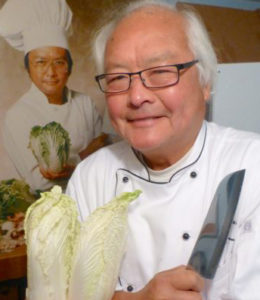Wok & Roll by Peter Kwong, (Frederic) Inter-County Leader
» Download this column as a Word document
So, your counter is cleaned, your knives are sharpened, and your apron is crisp, with a matching towel resting on your shoulder. You are ready to Wok & Roll.
Now let’s talk about the basic ingredients we need for the show. Thank goodness most grocery stores are stocked up with some of the essential ingredients for Chinese food these days, which makes our shopping simpler.
These are the basic things that I keep in my kitchen. Of course, down the road, you will enlarge your own inventory, I guarantee that. So here we go:

- Rice – I like long grain Jasmine rice. They have a nice aroma when cooked. There are varieties of rice from all over the world. Just pick one that you think you’ll like and give it a try.
- Sauces – Soy sauce, black bean paste with garlic, sesame oil, hot chili paste, hoisin sauce, oyster sauce, vinegar, cooking oil and cooking wine (I just use chardonnay).
- Dry Ingredients – corn starch, flour, sugar, salt and chicken base (better than MSG).
- Sides – baby corn, straw mushroom, bamboo shoots, water chestnuts and dried shiitake mushrooms (my all-time favorites).
- Other Staples – egg noodles, rice noodles and vermicelli.
Now we have all the dry goods, how about the other stuff? Again, these are my choices:
- Beef – I either use flank steak or sirloin. Flank steak is uniform in thickness and size, and is very tender, great with Chinese food. Years ago, they couldn’t even give them away. Now it costs almost $5 a pound!
- Chicken – Unless you have great knife skills, choose the boneless breast or thighs. I prefer thighs for better flavor.
- Pork – Rather than tenderloin, I prefer pork butts or shoulders. They’re tender, yet the meat has a bite to it.
- Fish – Salmon is an excellent choice. Grouper is great, too, but very expensive. Tilapia and panfish are o.k., but too flaky to cook in the wok.
- Shellfish – Shell-on shrimp has more flavor, but a lot of work to peel and clean them. The smaller number the size, the bigger and nicer the shrimp. For example, we have size 16-20, 25-30, 31-35, 36-40, etc. That’s how many shrimp you get for each pound. So, the larger the number, the smaller the size. Jumbo shrimp are usually size 16-20.
- Vegetables – I love farmers’ markets, and would usually pick whatever looks good and fresh to make something special. Most popular vegetables are napa cabbage, broccoli, bok choy, spinach, bean sprouts, carrots and celery. Garlic, scallion and ginger are a must!
Are we ready to Wok & Roll? So, let’s get started.
For next week, let’s try something easy and simple. We’ll make steamed rice and Cantonese beef and broccoli.



